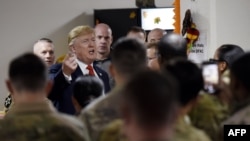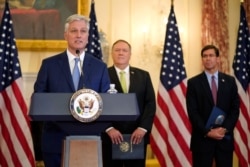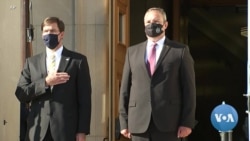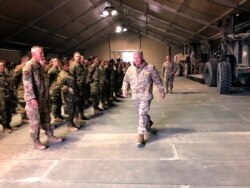The Pentagon offered no additional details on Afghanistan Thursday, a day after President Donald Trump tweeted that all U.S. forces in the South Asian nation should return home before the end of the year.
“We should have the small remaining number of our BRAVE Men and Women serving in Afghanistan home by Christmas!” Trump tweeted shortly before the vice -presidential debate Wednesday night.
Spokespersons for Defense Secretary Mark Esper, Joint Chiefs Chairman General Mark Milley and U.S. Central Command (CENTCOM), which oversees military operations in the Middle East, declined to comment and referred VOA to the White House. Esper did not answer questions on an Afghan withdrawal during a Pentagon event Thursday.
One military official, speaking on condition of anonymity, told VOA the president’s tweet was the “first word” anyone had seen about an accelerated withdrawal timeline in Afghanistan, and his office was “awaiting instructions” from the Pentagon’s policy team to “provide more guidance.”
Trump has called U.S. combat engagements overseas “ridiculous, stupid, endless, foreign wars,” and his recent tweet, if implemented, would fulfill his long-held campaign promise to get the United States out of Afghanistan. Most Americans also support bringing U.S. forces home.
The president’s tweet drastically accelerates plans released by his national security adviser, Robert O’Brien, who said hours earlier the United States intended to reduce its troop levels in Afghanistan from 5,000 to 2,500 by early 2021.
Secretary of State Mike Pompeo expressed a similar timeline to O’Brien in mid-September, saying the military was on pace for a full pullout by spring 2021.
The U.S. and the Taliban reached an agreement in February for the U.S. to remove all of its forces from Afghanistan by mid-2021 in return for assurances by the Taliban not to allow terrorist groups to use Afghan soil for international attacks.
The U.S. military is currently at around 5,000 forces in Afghanistan, as part of a planned withdrawal from 8,600 troops to 4,500 by November.
“At 4,500 we’re still going to be able to accomplish the core task that we want to accomplish,” CENTCOM Commander General Kenneth “Frank” McKenzie told VOA and two other outlets in an interview last month, referring to the need to continue supporting Afghan government allies currently negotiating with the Taliban, along with conducting counterterrorism operations to ensure that “entities such as al-Qaida and ISIS can’t be guests there to attack the United States.”
McKenzie also has stressed in multiple interviews with VOA that the U.S. needed to be confident the Taliban would not host Islamic State and al-Qaida terrorist groups before U.S. troops could exit further from Afghanistan, cautioning that the Taliban have “still not shown conclusively that they are going to break with al-Qaida.”
Bradley Bowman, with Washington-based research institute Foundation for Defense of Democracies, called Trump’s Wednesday tweet “politically motivated national security decision-making at its worst,” predicting that any rushed, timeline-based withdrawal in Afghanistan would lead to the U.S. military returning there “later at greater cost and sacrifice.”
“I guarantee you [military advisers] are advising against withdrawing our counterterrorism forces,” Bowman said. “Is the president of the United States going to blow of the advice of our top commanders that we should retain counterterrorism forces in the Afghanistan region, taking them away from the region that is arguably the most prominent terrorist region in the world? That would be foolish, reckless and dangerous.”
Afghanistan and Pakistan are home to at least 20 U.S.-designated terrorist groups, more than anywhere else in the world, according to the U.S. government.
“I don't think we can pull out of Afghanistan right now,” said Michael O’Hanlon, a senior fellow at the Brookings Institution, criticizing what he called Trump’s rhetoric on Afghanistan as “willingness to depart in a way that I think would be counterproductive for American interests.”
“More of the country would be at risk of turbulence, of instability, and therefore of being a viable place for al-Qaida or ISIS to put down sanctuary, put down roots and plan future attacks,” added O’Hanlon.
When asked about Trump’s tweet, NATO Secretary-General Jens Stoltenberg told reporters Thursday that the international effort in Afghanistan was a “conditions-based approach.”
“We will make decisions based on the conditions on the ground, because we think it is extremely important to continue to be committed to the future of Afghanistan, because it is in our interest to preserve the long-term security of Afghanistan,” said Stoltenberg.
“We decided to go into Afghanistan together; we will make decisions on future adjustments together, and when the time is right, we will leave together,” the NATO chief added.
While top U.S. military officials have remained quiet about what Trump’s tweet means, the Taliban said it considered the tweet “a positive step.”
A recent Eurasia Group Foundation survey found that most Americans from both U.S. political parties support the intra-Afghan peace talks backed by the Trump administration.
The nation’s longest war began in 2001 when U.S. forces invaded Afghanistan in response to the Sept. 11 terrorist attacks.













